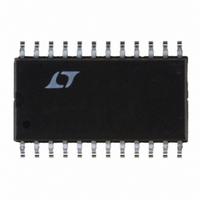LTC1273BCSW Linear Technology, LTC1273BCSW Datasheet - Page 11

LTC1273BCSW
Manufacturer Part Number
LTC1273BCSW
Description
IC A/D CONV 12BIT SAMPLNG 24SOIC
Manufacturer
Linear Technology
Specifications of LTC1273BCSW
Number Of Bits
12
Sampling Rate (per Second)
300k
Data Interface
Parallel
Number Of Converters
1
Power Dissipation (max)
75mW
Voltage Supply Source
Single Supply
Operating Temperature
0°C ~ 70°C
Mounting Type
Surface Mount
Package / Case
24-SOIC (0.300", 7.50mm Width)
Lead Free Status / RoHS Status
Contains lead / RoHS non-compliant
Other names
LTC1273BCS
Available stocks
Company
Part Number
Manufacturer
Quantity
Price
Part Number:
LTC1273BCSW
Manufacturer:
LT/凌特
Quantity:
20 000
Company:
Part Number:
LTC1273BCSW#PBF
Manufacturer:
LT
Quantity:
352
Part Number:
LTC1273BCSW#PBF
Manufacturer:
LINEAR/凌特
Quantity:
20 000
Part Number:
LTC1273BCSW#TRPBF
Manufacturer:
LINEAR/凌特
Quantity:
20 000
A
Effective Number of Bits
The Effective Number of Bits (ENOBs) is a measurement of
the resolution of an ADC and is directly related to the
S/(N + D) by the equation:
where N is the Effective Number of Bits of resolution and
S/(N + D) is expressed in dB. At the maximum sampling
rate of 300kHz the LTC1273/LTC1275/LTC1276 maintain
very good ENOBs up to the Nyquist input frequency of
150kHz. Refer to Figure 3.
Total Harmonic Distortion
Total Harmonic Distortion (THD) is the ratio of the RMS
sum of all harmonics of the input signal to the fundamental
itself. The out-of-band harmonics alias into the frequency
band between DC and half the sampling frequency. THD is
expressed as:
where V
quency and V
second through Nth harmonics. THD versus input fre-
N = [S/(N + D) – 1.76]/6.02
PPLICATI
THD = 20log
Figure 3. Effective Bits and Signal to (Noise + Distortion)
vs Input Frequency
1
is the RMS amplitude of the fundamental fre-
12
11
10
9
8
7
6
5
4
3
2
1
0
10k
2
f
SAMPLE
√V
O
through V
2
U
= 300kHz
2
INPUT FREQUENCY (Hz)
+ V
S
100k
3
I FOR ATIO
2
U
N
+ V
V
are the amplitudes of the
1
4
2
LTC1273/75/76 • F03
... + V
W
1M
N
2
2M
74
68
62
56
50
U
quency is shown in Figure 4. The LTC1273/LTC1275/
LTC1276 have good distortion performance up to Nyquist
and beyond.
Intermodulation Distortion
If the ADC input signal consists of more than one spectral
component, the ADC transfer function nonlinearity can
produce intermodulation distortion (IMD) in addition to
THD. IMD is the change in one sinusoidal input caused by
the presence of another sinusoidal input at a different
frequency.
If two pure sine waves of frequencies fa and fb are applied
to the ADC input, nonlinearities in the ADC transfer func-
tion can create distortion products at sum and difference
frequencies of mfa ± nfb, where m and n = 0, 1, 2, 3, etc.
For example, the 2nd order IMD terms include (fa + fb) and
(fa – fb) while the 3rd order IMD terms include (2fa + fb),
(2fa – fb), (fa + 2fb), and (fa – 2fb). If the two input sine
waves are equal in magnitude, the value (in decibels) of the
2nd order IMD products can be expressed by the following
formula:
IMD (fa ± fb) = 20log
–100
–10
–20
–30
–40
–50
–60
–70
–80
–90
Figure 4. Distortion vs Input Frequency
0
1k
f
SAMPLE
10k
= 300kHz
INPUT FREQUENCY (Hz)
LTC1275/LTC1276
Amplitude at (fa ± fb)
100k
Amplitude at fa
THD
2nd HARMONIC
3rd HARMONIC
1M
LTC1273/75/76 • F04
LTC1273
10M
11
127356fa














